If you want to engage in a deeper study of the principles, applications and possibilities of visual mapping and visual thinking, here are 8 books that I have personally read and recommend:
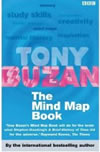 The Mind Map Book: Radiant Thinking – Major Evolution in Human Thought by Tony and Barry Buzan: This book does a better job of explaining the principles behind mind mapping – and why it’s such an incredibly powerful tool – than any other book I have ever read. It’s filled with engaging insights and tips, which I devoured when I first read this book. During the past few years, I have extracted several of these tips on this blog, including posts about:
The Mind Map Book: Radiant Thinking – Major Evolution in Human Thought by Tony and Barry Buzan: This book does a better job of explaining the principles behind mind mapping – and why it’s such an incredibly powerful tool – than any other book I have ever read. It’s filled with engaging insights and tips, which I devoured when I first read this book. During the past few years, I have extracted several of these tips on this blog, including posts about:
- Creating more powerful first-level topics for your mind maps and
- Buzan’s concept of basic ordering ideas.
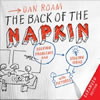 The Back of the Napkin: Solving Problems and Selling Ideas with Pictures by Dan Roam: The premise behind this book is simple: anybody with a pen and a scrap of paper can use visual thinking to work through complex business ideas. Everything in the book is broken down into steps, providing the reader with tools and rules to facilitate picture making. This is a fascinating book that I highly recommend.
The Back of the Napkin: Solving Problems and Selling Ideas with Pictures by Dan Roam: The premise behind this book is simple: anybody with a pen and a scrap of paper can use visual thinking to work through complex business ideas. Everything in the book is broken down into steps, providing the reader with tools and rules to facilitate picture making. This is a fascinating book that I highly recommend.
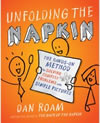 I just discovered that Roam recently published (just a few weeks ago) a companion workbook, entitled Unfolding the Napkin: The Hands-On Method for Solving Complex Problems with Simple Pictures. It helps readers put Roam’s principles into practice with step-by-step guidelines. It’s filled with detailed case studies, guided do-it-yourself exercises, and plenty of blank space for drawing. I plan to pick it up and will write a post about it in the near future.
I just discovered that Roam recently published (just a few weeks ago) a companion workbook, entitled Unfolding the Napkin: The Hands-On Method for Solving Complex Problems with Simple Pictures. It helps readers put Roam’s principles into practice with step-by-step guidelines. It’s filled with detailed case studies, guided do-it-yourself exercises, and plenty of blank space for drawing. I plan to pick it up and will write a post about it in the near future.
 Marks & Meaning by Dave Gray: This unique “book in progress” (sort of like an alpha or beta version of a piece of software) is available via print-on-demand service Lulu.com, and is an evolving exploration of visual language, visual thinking and visual work practices. Dave’s entire focus is on helping today’s information worker (that describes just about all of us!) to understand how to present information visually, in a meaningful and compelling way. The book is chock full of hand-drawn information s and examples, which I found to be quite interesting. It contains blank pages, where you can add notes and insights gained from it. Dave also provides some very compelling explanations of his visual thinking theories. It’s a work in progress because Gray really wants readers of it to give him their feedback and to add their ideas to it – making the final product a stronger, more comprehensive resource. Click here for my review of Marks & Meaning.
Marks & Meaning by Dave Gray: This unique “book in progress” (sort of like an alpha or beta version of a piece of software) is available via print-on-demand service Lulu.com, and is an evolving exploration of visual language, visual thinking and visual work practices. Dave’s entire focus is on helping today’s information worker (that describes just about all of us!) to understand how to present information visually, in a meaningful and compelling way. The book is chock full of hand-drawn information s and examples, which I found to be quite interesting. It contains blank pages, where you can add notes and insights gained from it. Dave also provides some very compelling explanations of his visual thinking theories. It’s a work in progress because Gray really wants readers of it to give him their feedback and to add their ideas to it – making the final product a stronger, more comprehensive resource. Click here for my review of Marks & Meaning.
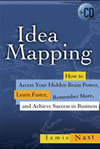 Idea Mapping: How to Access Your Hidden Brain Power, Learn Faster, Remember More and Achieve Success in Business by Jamie Nast: This excellent book teaches the basics of how to capture your ideas using “idea maps” – basically, mind maps that are focused on recording your ideas. While it tends to focus on hand-drawn maps, the principles and outlines are valuable for anyone doing software-produced maps, as well. In addition to teaching readers how to create idea maps, the book also covers topics such as applications of idea maps and how to use them in a team setting, and it also includes a number of maps produced by real-world business people. Click here to read my review of it.
Idea Mapping: How to Access Your Hidden Brain Power, Learn Faster, Remember More and Achieve Success in Business by Jamie Nast: This excellent book teaches the basics of how to capture your ideas using “idea maps” – basically, mind maps that are focused on recording your ideas. While it tends to focus on hand-drawn maps, the principles and outlines are valuable for anyone doing software-produced maps, as well. In addition to teaching readers how to create idea maps, the book also covers topics such as applications of idea maps and how to use them in a team setting, and it also includes a number of maps produced by real-world business people. Click here to read my review of it.
 Thinking Visually: Business Applications of 14 Core Diagrams by Malcolm Craig: If you are interested in learning more about the larger context within which visual mapping fits, then you will really enjoy this book. It gave me a deeper appreciation of some of the theory behind visual diagramming and why it is so effective as a business problem-solving tool. Visual tools covered in Thinking Visually include system maps, mind maps, relationship diagrams, and tree, influence, input-output, control, fishbone and force field diagrams. Finally, Craig offers contains a wealth of practical advice on how to use the diagrams to manage information overload. Craig’s writing style is highly accessible and informative. Put this one on your must-read list! Click here for my review of it.
Thinking Visually: Business Applications of 14 Core Diagrams by Malcolm Craig: If you are interested in learning more about the larger context within which visual mapping fits, then you will really enjoy this book. It gave me a deeper appreciation of some of the theory behind visual diagramming and why it is so effective as a business problem-solving tool. Visual tools covered in Thinking Visually include system maps, mind maps, relationship diagrams, and tree, influence, input-output, control, fishbone and force field diagrams. Finally, Craig offers contains a wealth of practical advice on how to use the diagrams to manage information overload. Craig’s writing style is highly accessible and informative. Put this one on your must-read list! Click here for my review of it.
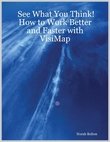 See What You Think! How to Work Better and Faster with VisiMap by Norah Bolton: This e-book is filled with practical examples of mind mapping in action (both hand drawn and software produced). Norah believes that visual mapping represents a new “language” for communicating ideas. Seen as a type of “language” for representing ideas, visual mapping literally makes it possible for us to consider our ideas in powerful new ways that aren’t possible when they are represented in the conventional linear fashion. Click here to read my review of it.
See What You Think! How to Work Better and Faster with VisiMap by Norah Bolton: This e-book is filled with practical examples of mind mapping in action (both hand drawn and software produced). Norah believes that visual mapping represents a new “language” for communicating ideas. Seen as a type of “language” for representing ideas, visual mapping literally makes it possible for us to consider our ideas in powerful new ways that aren’t possible when they are represented in the conventional linear fashion. Click here to read my review of it.
 Power Tips & Strategies for Mind Mapping Software: This is a popular e-book that I wrote. It summarizes business applications and best practices for utilizing mind mapping software, and contains a wealth of ideas, tips and strategies that you can put to work today to increase your effectiveness and efficiency – no matter which software program you use. I didn’t include it in this list to give it a shameless plug, but because it has been a popular resource for visual mappers during the last few years.
Power Tips & Strategies for Mind Mapping Software: This is a popular e-book that I wrote. It summarizes business applications and best practices for utilizing mind mapping software, and contains a wealth of ideas, tips and strategies that you can put to work today to increase your effectiveness and efficiency – no matter which software program you use. I didn’t include it in this list to give it a shameless plug, but because it has been a popular resource for visual mappers during the last few years.
What books do you recommend?

Leave a Reply